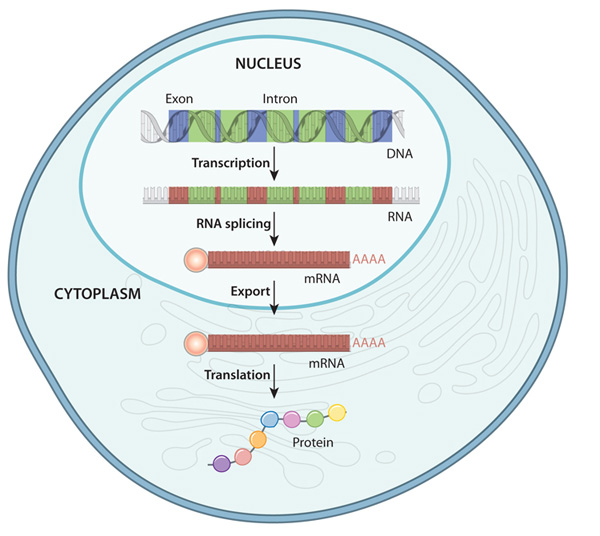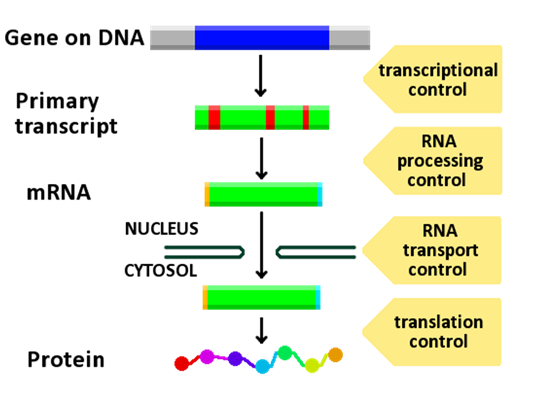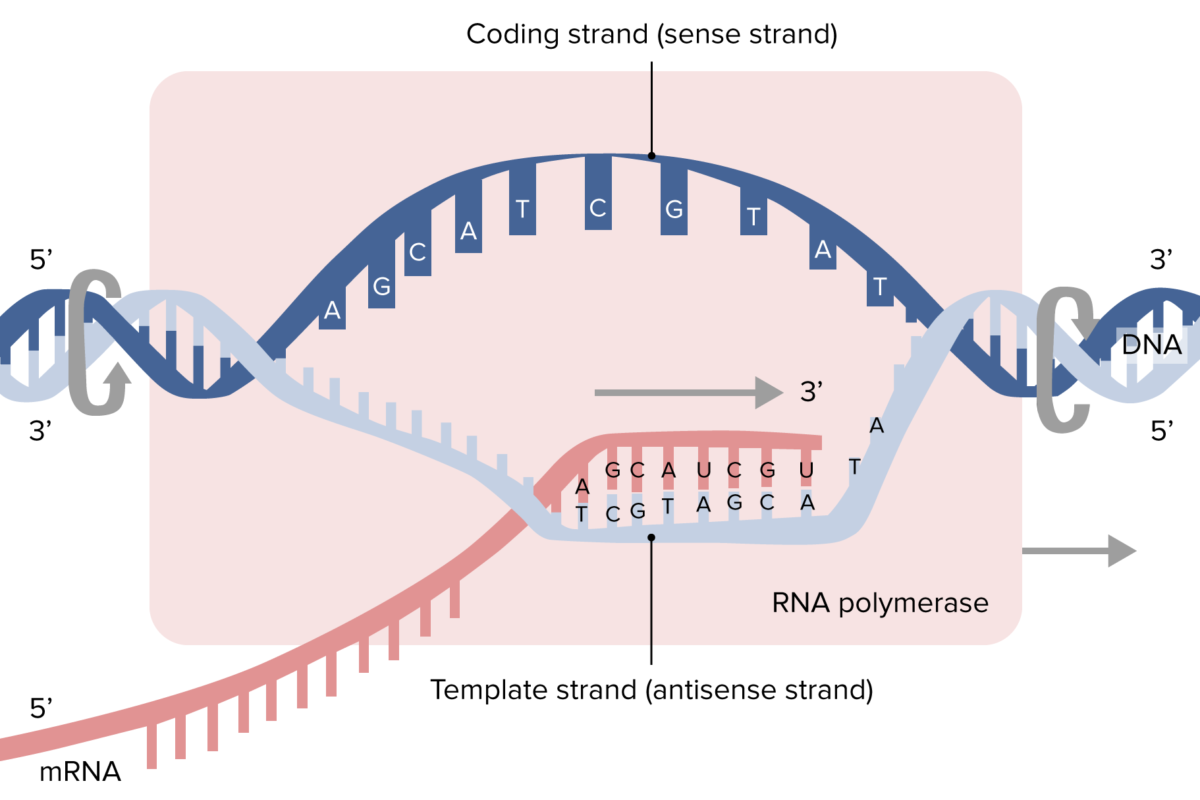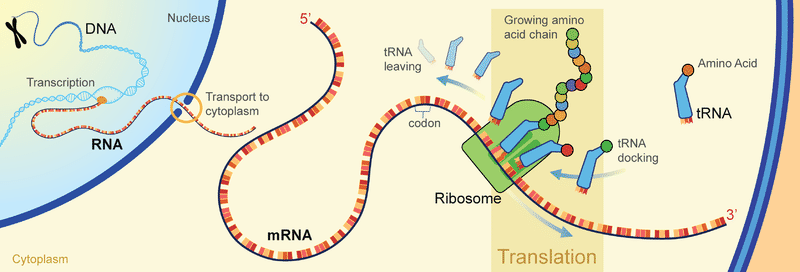Gene Expression Study Guide
Introduction:
A DNA molecule is more than simply a series of nucleotides. Instead, it is broken down into functional pieces known as genes. Each gene encodes a functional product or a molecule that performs a certain function in the cell. A protein is frequently the functional result of a gene.
The method through which a gene’s genetic code – the nucleotide sequence – is employed to drive protein synthesis and generate the cell’s structures is known as gene expression. Structural genes are genes that code for amino acid sequences.
Process of Gene Expression
The process of gene expression contains two main basic processes: Transcription and Translation.
Transcription – The messenger RNA is created in this stage with the help of RNA polymerase enzymes, culminating in the processing of the mRNA molecule.
Translation – The primary purpose of mRNA is to guide protein synthesis, which leads to post-translational modification of the protein molecules.
Regulation of Gene Expression
- Gene expression is the process through which our DNA instructions are translated into a useful output, such as a protein. This is a well-coordinated mechanism that permits a cell to adapt to changes in its surroundings.
- With the help of translation and transcription, genetic instructions from the DNA code are turned into a protein during gene expression.
- The process of an organism’s genetic composition manifesting into physical features is referred to as genetic expression. Information is transferred from genes to proteins in this process.
Let’s look at the keratin genes as an example. Keratin is a protein that has a role in developing our hair, nails, and skin. In most situations, these things continue to develop constantly while our hair, nails, and skin wear down over time. Excessive keratin production can result in a lot of hair on the skin, dry and hard skin, and thick and long nails. To avoid this, the expression of the keratin gene must be regulated.
Gene expression regulation refers to several processes by which our cells control the quantity of protein generated by our genes.
Transcription:
Transcription is the process of creating an mRNA molecule from DNA. Transcription is analogous to DNA replication, except that instead of double-stranded DNA, single-stranded RNA is created. Only one strand of DNA is utilized as a template in transcription.
Don’t forget to check out our Transcription Simulation – it makes studying this guide a lot easier!
Translation:
The translation is the process of making a protein by reading the genetic information in mRNA. The mRNA is read one codon at a time. A ribosome is where translation takes place. A protein is created utilizing the codons in mRNA as a guide during translation. The procedure involves all three kinds of RNA.
Conclusion:
- Gene expression is the process through which a gene’s genetic information, or nucleotide sequence, is employed to make a functional gene product.
- The process of gene expression contains two main basic processes: Transcription and Translation.
- The interplay between promoters and enhancers controls transcription, which is the process of RNA production.
- The mature mRNA molecule serves as a template for assembling a succession of amino acids into a polypeptide with a specified amino acid sequence during translation.
FAQs:
1. What is gene expression?
Gene expression is the method through which a gene’s genetic code or a nucleotide sequence is employed to drive protein synthesis and generate the cell’s structures.
2. What is an example of gene expression?
All organisms have a determined set of DNA that determines all the characteristics of an individual. But the expression of these traits in an individual is carried out through gene expression. For example, a child receives an X chromosome from both the mother and the father. This child will be born a female and will develop all the characters of a human female. This is made possible through the process of gene expression.
3. What is gene expression, and why is it important?
Gene expression is the process through which a gene’s genetic information, or nucleotide sequence, is employed to make a functional gene product. Gene expression determines the characters of an individual. Genes code for all sorts of proteins that are essential for the survival of an organism. But only the presence of DNA is not sufficient. Its proper regulation and expression is also important.
4. What causes gene expression?
Molecular factors inside the cell, mutations create dominant-negative effects and haploinsufficiency, signaling molecules from neighboring cells and the environment, and epistasis, all impact gene expression. Gene expression is controlled by a variety of substances within the cell.
5. How would you explain gene expression to a child?
Gene expression is how a cell reads the genetic instructions written in DNA to generate the chemical it requires. To do so, the cell decodes the genetic code and adds one of the 20 distinct amino acids, which are the building blocks of proteins, to each group of three letters.
6. What are the two processes of gene expression?
Transcription and translation are the two main processes of gene expression.
7. Where does gene expression takes place?
In prokaryotes, due to the lack of a well-defined nucleus, both gene expression processes take place in the cytoplasm. In eukaryotes, gene expression occurs both inside the nucleus (transcription) and in the cytoplasm (translation).
8. Why is studying gene expression important?
Because many genes are coregulated, researchers may use microarrays or massively parallel sequencing to look at gene expression over the whole genome to identify which sets of genes are coregulated during differentiation, cancer, and other states and processes.
We hope you enjoyed studying this lesson and learned something cool about Gene Expression! Join our Discord community to get any questions you may have answered and to engage with other students just like you! Don’t forget to download our App to experience our fun, VR classrooms – we promise, it makes studying much more fun! 😎
Sources:
- What is gene expression?. https://www.yourgenome.org/facts/what-is-gene-expression. Accessed on 30 Nov, 2021.
- Gene Expression. https://www.genome.gov/genetics-glossary/Gene-Expression. Accessed on 30 Nov, 2021.
- Gene Expression. https://flexbooks.ck12.org/cbook/ck-12-biology-flexbook-2.0/section/4.11/primary/lesson/gene-expression-bio/. Accessed on 30 Nov, 2021.




